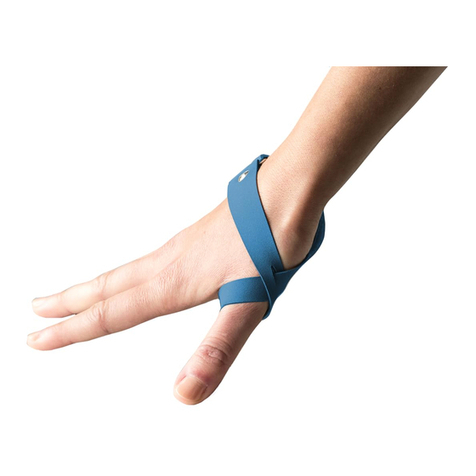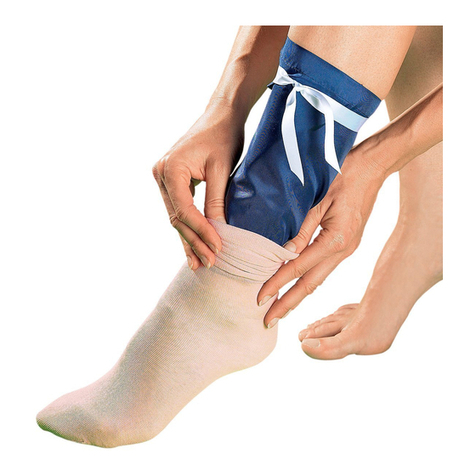
Gebrauchsanweisung
Hallux valgus/ Hammerzehe: Bitte beachten Sie die geteilte(n) Zehenbox(en)
beim Anziehen der Socke. Raffen Sie die Socke zusammen und positionieren
Sie zuerst die Großzehe in der dafür vorgesehenen Zehenbox. Verfahren Sie bei
Hammerzehen Korrektursocken mit der kleinen Box der zweiten Zehe genauso.
Das Tapingband für die Hammerzehe muss über
das Mittelglied in Richtung Grundgelenk gezogen
werden, so dass das Zugband über der Erhöhung/
Beugung platziert ist (siehe Bild). Keinesfalls sollte
das Hammerzehen-Tape vor der Erhöhung sitzen,
da
ansonsten erhebliche Gefahr besteht, die Fehlstellung
zu verstärken.
Im nächsten Schritt positionieren Sie die restlichen Kleinzehen in der verblei-
benden Zehenbox und ziehen anschließend die Taping Socken Richtung Ferse
nach oben und achten auf den korrekten Sitz der Zugbänder. Um die Funktion
zu gewährleisten sollten die Tapingbänder auf Spannung /Zug und die Zehen
vollständig in den Zehenboxen möglichst straff und faltenfrei sein. Sitzt die Socke
zu locker, ist die Korrekturfunktion eingeschränkt. Bitte wählen Sie in diesem Fall
eine kleinere Größe.
Knick-Senkfuß/Pronation Control: Bitte achten Sie beim Anziehen auf die
richtige Socke für Rechts und Links. Eine entsprechende Markierung befindet
sich außen auf dem Tapingband.
Die Tapingbänder teilen sich in zwei
Funktionsbereiche. Das Fersenband
verläuft auf der Außenseite vom
Ansatz der Achillessehne unterhalb
des Außenknöchels zur Fußsohle. Das
Tapingband berührt mit der oberen
Kante leicht den Außenknöchel 1.
Das vordere Tapingband verläuft von der Fußsohle im 45°-Winkel zum Ballen-
bereich am Fußrücken. Die vordere Kante liegt hinter den Kleinzehen 2.
Auf der Innenseite verläuft das Band ebenfalls vom Ansatz der Achillessehne
unterhalb des Innenknöchels Richtung Fußsohle. Auch hier berührt das es den
Innenknöchel leicht mit der oberen Kante 3. Durch den Zug des Tapingbandes
wird die Ferse in ihrer richtigen Position stabilisiert und die innere Längs-
wölbung aufgerichtet 4.
Das vordere Tapingband auf der Innen-
seite stabilisiert den ersten
Mittel-
fußknochen Richtung Boden
5
.
Bitte
überprüfen Sie die richtige Position mit
der Zweifingertechnik. Dazu steht der
Unterschenkel im 90°-Winkel zum Fuß,
legen Sie Ihren Zeige- und Mittelfinger in
die Fußbeuge 6. Liegt die hintere Kante
des Tapingbandes im Anschluss zu Ihrem
Mittelfinger, ist es richtig positioniert 7.
1
2
3
4
5
6
7
6





























